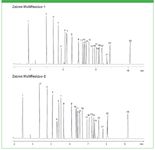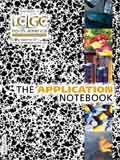Fast Chlorinated Pesticide Analysis Using Zebron™ MultiResidue™ GC Columns
The US EPA regulates the testing of 20 specific chlorinated pesticides under the official Method 8081. Zebron MultiResidue columns achieve baseline separation of all of these analytes with short run times, providing greater confidence in identification and increased lab productivity.
The US EPA regulates the testing of 20 specific chlorinated pesticides under the official Method 8081. Zebron MultiResidue columns achieve baseline separation of all of these analytes with short run times, providing greater confidence in identification and increased lab productivity.
The use of many pesticides has been restricted or banned due to the health and environmental risks they pose. The persistence of these harmful compounds in the environment has left many sites contaminated and in need of remediation. There is an essential need to monitor products, especially foods, for pesticides to ensure safety. The following application provides a dual column method for analyzing chlorinated pesticides by EPA Method 8081, which determines the concentrations of various organochlorine pesticides in extracts from solid and liquid matrices using gas chromatography with electron capture detectors (ECD).
Experimental Conditions
Simultaneous identification can be performed using two GC columns of differing selectivity in a parallel configuration. A Zebron ZB-MultiResidue-1 of 30 m × 0.32 mm × 0.50 µm dimensions and a ZB-MultiResidue-2 column of 30 m × 0.32 mm × 0.25 µm dimensions were used (Phenomenex, Torrance, California), with a 5 m Zebron Z-Guard™ (Phenomenex) and a Y-Splitter. The splitless injection of 1.0 µL of analytes was made with constant flow Helium at 3.4 mL/min. The oven program was 100 °C for 0.5 min to 220 °C at 35 °C/min to 340 °C at 20 °C/min for 2 min.
Discussion
Figure 1 shows the specified method using Zebron MultiResidue columns, which offer proprietary, unique selectivity that provides baseline resolution of all 20 compounds analyzed within EPA Method 8081 in 10 min. This allows for more robust methods, short cycle times, and increased lab productivity. Additionally, both ZB-MultiResidue-1 and -2 columns are MS Certified, and can be used with screening methods to test for multiple classes of pesticides and use MS for confirmation.

Figure 1: Baseline resolution of 20 chlorinated pesticides in 10 min. 1 = 2,4,5,6-Tetrachloro-m-xylene (TCMX), 2 = 1-Bromo-2-nitrobenzene, 3 = a-BHC, 4 = g-BHC (Lindane), 5 = b-BHC, 6 = d-BHC, 7 = Heptachlor, 8 = Aldrin, 9 = Heptachlor epoxide, 10 = g-Chlordane, 11 = a-Chlordane, 12 = Endosulfan I, 13 = 4,4’-DDE, 14 = Dieldrin, 15 = Endrin, 16 = 4,4’-DDD, 17 = Endosulfan II, 18 = Endrin aldehydes, 19 = 4,4’-DDT, 20 = Endosulfan sulfate, 21 = Methoxychlor, 22 = Endrin ketone, 23 = Decachlorobiphenyl (DCB, surr).
Conclusions
The Zebron MultiResidue dual column method for organochlorine pesticide analysis allows for 10 min separation, resulting in short cycle times and improved productivity for labs under tight production deadlines. Improved baseline resolution offers more consistent quantitation and greater method robustness, minimizing the possibility of misidentified peaks and removing quantitation complications arising from closely eluting peaks. Though each Zebron MultiResidue phase was optimized to resolve a specific set of analytes for EPA Method 8081, the columns represent a solution for all classes of pesticide analysis. To learn more, please contact Phenomenex or visit www.phenomenex.com/MultiResidue.
Phenomenex Inc.
411 Madrid Avenue, Torrance, CA 90501
tel. (310) 212-0555, fax (310) 328-7768
Website: www.phenomenex.com

Separation of Ultra-Short and Long Chain PFAS Compounds Using a Positive Charge Surface Column
December 11th 2024A separation of ultra-short and long chain PFAS (C1-C18) is performed on a HALO®PCS Phenyl-Hexyl column along with a HALO®PFAS Delay column which demonstrates excellent retention for both hydrophilic and hydrophobic analytes.















